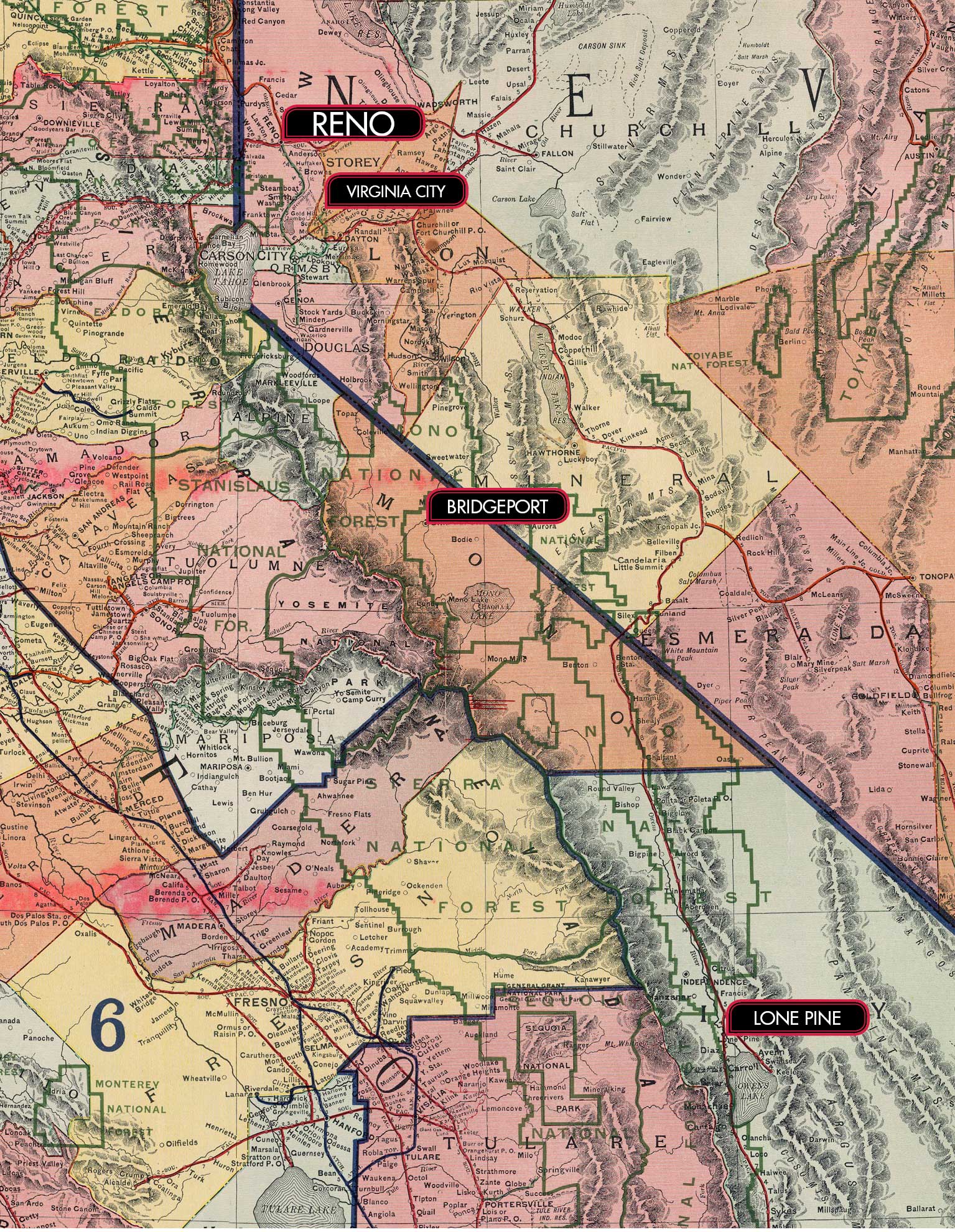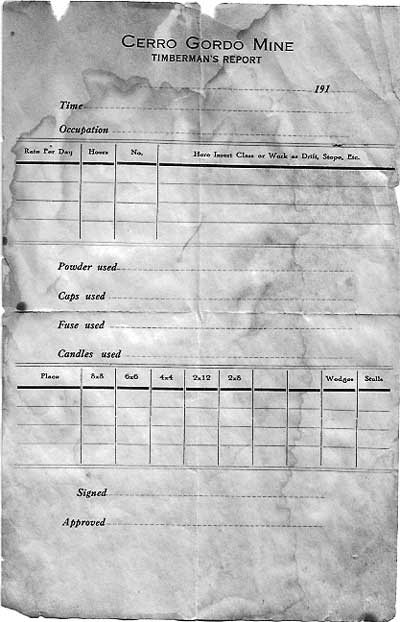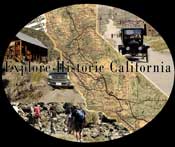Most recently,
I found myself in a rare winter visit to Cerro Gordo in the
twenty first century. Roger and I were helping, to watch over
the town for a few days. The roads were dry and in relatively
good condition all the way up, except for a few icy patches in
front of our little cabin up there. Temperatures dipped to
between 25 and 50 degrees, depending upon the time of day and
whether it was cloudy or sunshiny.
 |
|
A
"warm" winter day in Cerro Gordo (Jan 24, 2014) with
an outside temperature of about 35 degrees. View is
looking west down Main Street. The museum is to the
right and Owens Lake and the Sierra Nevada Mountains
are in the distance. |
On one sunshiny
day, my friend Jaclynn and I took advantage of the relative
warmth and sat in the swing off the deck of the American Hotel
with a good view of the Yellow Grade and anyone coming in to
town. It had been fairly quiet so we weren’t expecting anyone in
particular to come up.
Suddenly, we
notice a truck driving through, and we waved at them to stop. An
older man and woman were in it and the man said they just wanted
to do a drive through now and see how the town was surviving,
and would be back for a visit later. Our conversation, I from
the porch of the hotel, and he from the main road down below,
was polite and friendly, and consisted of a lot of history
between the two of us. He reflected on many visits to Cerro
Gordo and surrounding areas in the old days, with his father,
and when I asked him his name he simply replied, "Skinner." I
smiled and said, “Any relation to Max Skinner?” and he said,
"yes". A few days later when I headed back home to Los Angeles,
I thought it was time to hit my books and see why the name
Skinner sounded so familiar.
According to my
resources, the Skinner story starts with Joseph V. Skinner, who
was born in 1839, the first white child born in Fort Madison,
Iowa, and the first child born to the John Skinner family,
originally of Mohawk Valley, New York. In 1859, Joseph showed an
interest in mining and went to Colorado. The Civil War broke out
and he wound up fighting Indians with a Colorado regiment,
instead. Joseph Skinner’s tales of the Battles of Sand Creek and
of Apache Canyon were retold often to his children and
grandchildren. A spot on his scalp, bald from a scar, was
testament to the arrow that grazed his temple, ear, and scalp
moments after seeing an Indian behind a log at Sand Creek.
As the Civil
War ended, Joseph returned to Iowa. There he met Marguerite Jane
Robinson and by 1867, Marguerite and Joseph were married. In
1876, they found themselves in Missouri buying and selling
cattle. Joseph had asthma, however, and doctors ordered him to a
more favorable climate. He remembered his friend, Mary Huber,
the wife the Virginia City Yellow Jack Mine superintendent, and
she told him there was work there if only he would come.
Joseph boarded
a train to Reno, Nevada, arriving in March of 1878. He spent one
winter as Virginia City's undersheriff, then hooked up with the
Barnes brothers of Bridgeport who operated a way station. He
moved to Big Meadows, as Bridgeport was called in its early
days. In addition to homesteading a ranch, he started a
freighting business hauling perishables from Carson City to
Bodie for $3.50 a pound. With the profits he made from the
freighting, he was able to buy bigger teams and wagons to haul
heavier freight.
The following
year, 1879, Joseph sent for his family to join him. Marguerite
packed up their four children ages twelve to two; Jessie, Max,
Fred, June and Bill. They travelled by train 1for two weeks,
with sleeping bunks and a stove to cook their meals along the
way. Marguerite brought large quantities of bologna, sausage and
French twist bread, which they primarily ate along the way.
Jessie would recall that she had so much bologna and French
twist bread on that trip, she couldn’t stand the thought of
eating again in her adult years.
They travelled
through wild land with large herds of buffalo, antelope and deer
that often delayed the train as they crossed the tracks. Nights
were travelled without lights on the train, since a previous
train had been attacked by Indians. When they arrived in Reno,
Joseph met them and loaded them on the Virginia and Truckee
Railroad for Carson City. From there they boarded a covered
wagon and headed south for Bridgeport with an overnight stop at
Sweetwater which was hosted at the way station run by Tom
Williams and his family.
The Skinner
family officially arrived in Bridgeport on March 11, 1880. Snow
covered the valley and it was bitter cold. The homesteaded ranch
they called their home is now known as the Hunewill Ranch.
Joseph supported the family teaming from the forest saw mills to
Bodie which was still in its boom cycle. The Bodie Railroad had
yet to be built.
 |
|
Map
showing Skinner family travels from Reno, Nevada, to
Lone Pine, Calif. Map base is 1912 Rand McNally
New County and Road Map of California and Nevada.
(Map courtesy of David Rumsey Historical Map
Collection) |
The children
attended schools in Bridgeport for one year. Joseph’s wife,
Marguerite, was often homesick for her friends and green wooded
hills. She would go out in the tall rabbit brush for a good cry
to get it out of her system, then return with a smile, because
she knew Joseph’s asthma required they remain in the West.
From the big
meadows of Bridgeport, the Skinners decided to take their team
over the Sonora Pass to Stanislaus County. Joseph teamed up with
Jimmy Barnes for a successful winter plowing wheat fields.
Barnes longed for Bridgeport, however, so by February, 1882,
they were planning the return trip.
Winter snows
required them to look for a southern passage over the Sierras.
They camped at White River until Green Horn Pass opened. At
Coyote Holes they noted barrels of water and grain left by other
travelers for return trips.
The family
arrived in Lone Pine in the Owens Valley May 10, 1882. “This is
where we are going to stay,” Marguerite announced. The family
rented the property known as the McCall Ranch and it became
their home. Another child, Lloyd, was born that same year. This
was during a period of conflicts between Indians and Mexicans.
Jessie and Max would pass by a dead Indian or Mexican along the
way to school. The ranch remained their home until 1884, when
they moved into what was known as the Castro House in Lone Pine.
Joseph relied
on his freighting skills once again, hauling from Mojave to
Bishop. On return trips he carried wheat and ore south from the
mines. He also burned charcoal in the kilns near Cartago and
hauled it to Owens Lake to be shipped to the smelter at Swansea.
He also hauled equipment to Saline Valley.
Jessie Skinner,
the eldest daughter, married Finley MacIver. They homesteaded a
ranch east of the river near the Reward Mine. Finley MacIver
became the superintendent for the Carson Company which built the
East Side Canal to irrigate ranches. Dry land became lush fields
of alfalfa and blooming orchards thanks to that irrigation. The
company attracted a colony of Quakers that settled around Owenyo.
They had no experience with irrigation or desert living.
The Quakers
sold out to the City of Los Angeles in 1905, cutting water
supplies for neighboring Skinner and MacIver ranches. In 1908,
the Skinners sold their ranch to the City of Los Angeles, and
purchased the old Lubkin place in Lone Pine. Sons, Lloyd, Bill,
and Bill’s family shared a ten acre block there. Bill eventually
owned the place until he also sold to the City of Los Angeles
around 1932. A portion of the property was given to Max Skinner
and was owned by his widow after he died. Joseph Skinner died in
Lone Pine in 1922, Marguerite moved to Eugene, Oregon, with son
Bill and his family, and lived there until 1933. Both Joseph
and Marguerite are buried in the Independence cemetery.
The Skinner
children all did well for themselves, but it was Max Skinner who
took up freighting like his father. He hauled freight from
Darwin and Owens Valley to Mojave. In Mojave he met a Harvey
girl by the name of Harriet Wilbert, and married her. He owned
the Skinner Store in Lone pine where La Florista is. Max had
hopes of going to West Point, and passed the examination.
Unfortunately as he rode from Lone Pine to Mojave by mule
infection set in his ear, which disqualified him for
appointment, so he took work on the Los Angeles Aqueduct. He
owned his general merchandise store for many years, then sold it
to become an insurance agent and justice of peace.
So I leave our
readers with these tidbits for now and the promise of more tales
from Max Skinner himself, next month.
Thanks to Paul
Skinner, for sending us on the research trail after our chance
visit up at Cerro Gordo and thanks to Paul for sending us a
picture of this treasure from his own family files.
 |
|
Cerro
Gordo Mine Timberman's Report (early 20th
Century).
(Courtesy Paul Skinner Collection) |
Bibliography
The Album Times & Tales of Inyo-Mono, Vol. V No.4.
Chalfant Press, Inc.
October, 1992
A Skinner Family Record by
Frances V. McIver & Pat Boyer
Conversation with Paul Skinner at Cerro
Gordo (January, 2014)
David Rumsey Historical Map Collection
(http://www.davidrumsey.com/)
